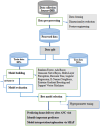Machine-learning algorithm to predict home delivery after antenatal care visit among reproductive age women in East Africa
- PMID: 40538911
- PMCID: PMC12176903
- DOI: 10.3389/fgwh.2025.1461475
Machine-learning algorithm to predict home delivery after antenatal care visit among reproductive age women in East Africa
Abstract
Background: Maternal and child health remains a global public health issue, particularly in low- and middle-income countries where maternal and child mortality are extremely high. The World Health Organization estimates that close to 287,000 women die annually due to pregnancy and childbirth complications, and the majority of these deaths occur where skilled birth attendants are not readily available. Reducing the prevalence of home delivery is a key strategy for lowering the maternal mortality rate. Although several studies have explored home delivery and antenatal care (ANC) utilization independently, limited evidence exists on predicting home delivery after ANC visits using machine-learning approaches in East Africa.
Methods: This study utilized a community-based, cross-sectional design with data from the most recent Demographic and Health Surveys conducted between 2011 and 2021 in 12 countries in East Africa countries. A total weighted sample of 44,123 women was analyzed using Python version 3.11. Nine supervised machine-learning algorithms were applied, following Yufeng Guo's steps for supervised learning. The random forest (RF) model, selected as the best-performing algorithm, was used to predict home delivery after ANC visits. A SHapley Additive exPlanations analysis was conducted to identify key predictors influencing home delivery decisions.
Results: Home delivery after ANC visits was most prevalent in Malawi (17.88%), Uganda (15.38%), and Kenya (11.3%), and was low in Comoros (2.38%). Living in rural areas and late ANC initiation (second trimester) increased the likelihood of home delivery. In contrast, factors such as higher household income, husband's level of primary and secondary education, contraceptive use, shorter birth intervals, absence of distance-related barriers to healthcare, and attending more than four ANC visits were associated with a lower likelihood of home delivery.
Conclusion: The study demonstrates that home delivery after ANC visits was high. The RF machine-learning algorithm effectively predicts home delivery. To reduce home deliveries, efforts should improve early ANC initiation, enhance healthcare quality, and expand facility-based services. Policymakers should prioritize increasing health facility accessibility, promoting media-based health education, and addressing financial barriers for women with low incomes. Strengthening these areas is crucial for improving maternal and neonatal health outcomes in East Africa.
Keywords: ANC visit; East Africa; home delivery; machine learning; prediction.
© 2025 Walle, Kebede, Adem and Mamo.
Conflict of interest statement
The authors declare that the research was conducted in the absence of any commercial or financial relationships that could be construed as a potential conflict of interest.
Figures






Similar articles
-
Socio-economic and cultural factors associated with the utilization of maternal healthcare services in Togo: a cross-sectional study.Reprod Health. 2023 Jul 25;20(1):109. doi: 10.1186/s12978-023-01644-6. Reprod Health. 2023. PMID: 37488593 Free PMC article.
-
Application of machine learning algorithms to model predictors of informed contraceptive choice among reproductive age women in six high fertility rate sub Sahara Africa countries.BMC Public Health. 2025 May 29;25(1):1986. doi: 10.1186/s12889-025-23242-w. BMC Public Health. 2025. PMID: 40442626 Free PMC article.
-
Determinants of antenatal care service utilisation in sub-Saharan Africa: an analysis of demographic and health surveys data (2015-2022).Arch Public Health. 2025 Jul 17;83(1):189. doi: 10.1186/s13690-025-01608-1. Arch Public Health. 2025. PMID: 40676660 Free PMC article.
-
Factors that influence the provision of intrapartum and postnatal care by skilled birth attendants in low- and middle-income countries: a qualitative evidence synthesis.Cochrane Database Syst Rev. 2017 Nov 17;11(11):CD011558. doi: 10.1002/14651858.CD011558.pub2. Cochrane Database Syst Rev. 2017. PMID: 29148566 Free PMC article.
-
Home treatment for mental health problems: a systematic review.Health Technol Assess. 2001;5(15):1-139. doi: 10.3310/hta5150. Health Technol Assess. 2001. PMID: 11532236
References
-
- Devkota B, Maskey J, Pandey AR, Karki D, Godwin P, Gartoulla P, et al. Determinants of home delivery in Nepal–A disaggregated analysis of marginalised and non-marginalised women from the 2016 Nepal Demographic and Health Survey. PLoS One. (2020) 15(1):e0228440. 10.1371/journal.pone.0228440 - DOI - PMC - PubMed
LinkOut - more resources
Full Text Sources

